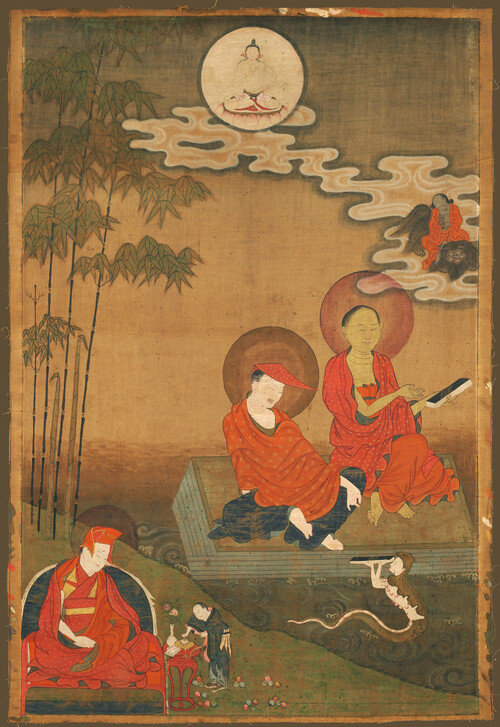Seated in the center on the left is the Indian Buddhist scholar Nāgārjuna (2nd/3rd c.), held to be the founder of the Madhyamaka, the “Middle Way,” school. The Madhyamaka is one of the three main schools, alongside the Yogācāra and Tathāgatagarbha, of the Mahāyāna (“Great Vehicle”) tradition. Mahāyāna Buddhist works emphasize that the final goal of the spiritual aspirant is full Buddhahood, with all the powers associated with it, as opposed to the achievement of nirvāṇa of the more conservative Buddhist traditions. According to legend, Nāgārjuna was given the Prajñāpāramitā (“Perfection of Wisdom”) texts, whose teachings he grounded with logical arguments, by the mythical water-dwelling nāgas. To the right of Nāgārjuna sits Āryadeva (3rd c.), traditionally said to have been Nāgārjuna’s disciple, who composed influential Madhyamaka works. White Mañjuśrī, the deity of wisdom, appears at the top of the painting. His emanation rides a shaggy lion characteristic of Chinese depictions of Mañjuśrī. An unidentified Tibetan scholar is seated at the lower left beside an attendant lighting incense in a brazier bowl.
Technical details
Origin: Eastern Tibet. Date: 19th c. Painting School: Karma Gardri. Medium: Distemper on cotton. Dimensions: 23.75 x 15.5 in. Collection: Rubin Museum of Art.Source: Wikimedia Commons, Google Art Project.
